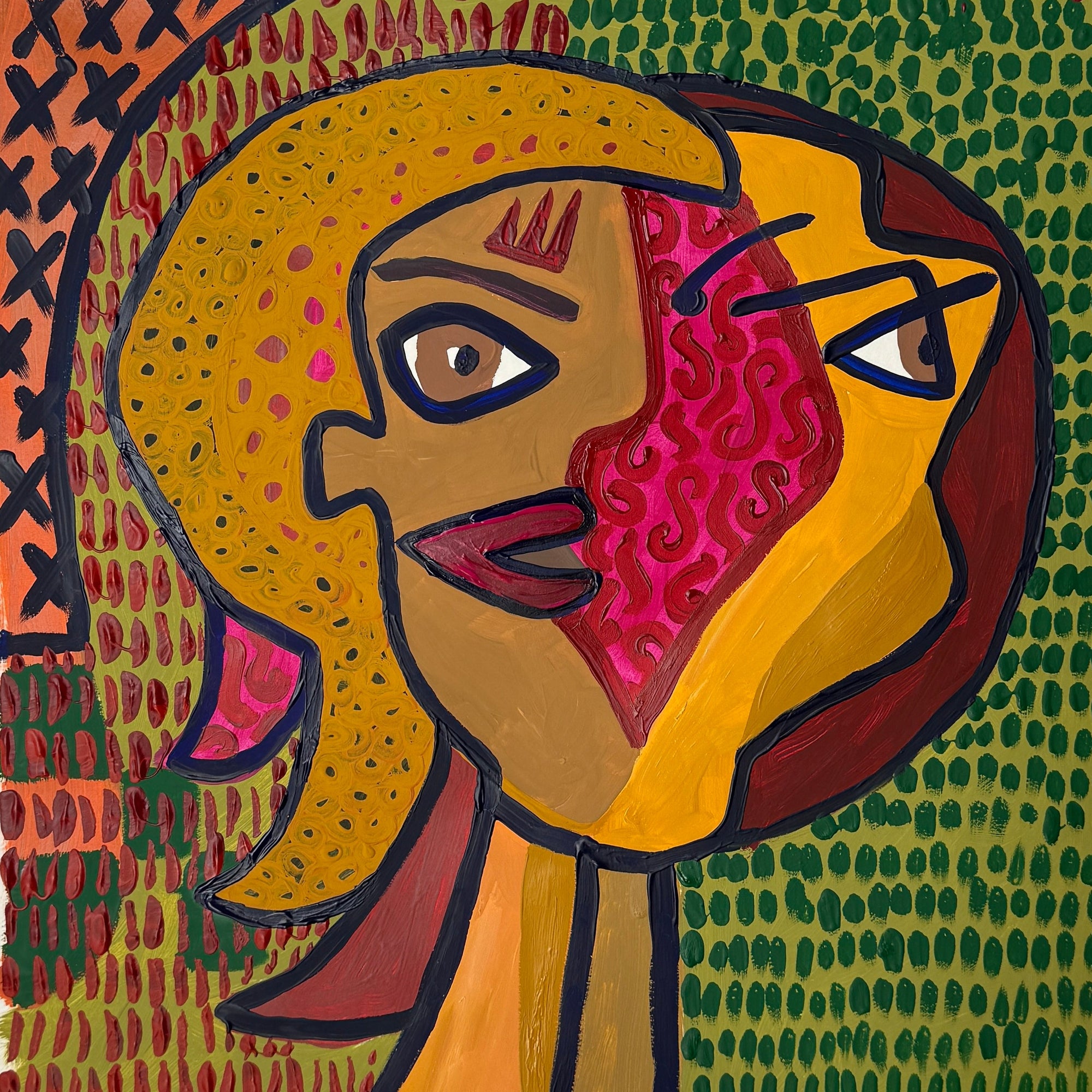
©shanihodson2025
This learning experience aligns with the Visual Arts Curriculum 2.0, by fostering students' ability to explore, develop, create, and present artwork while engaging with historical and contemporary artistic practices. Through the study of Pablo Picasso, students will analyse how visual conventions communicate meaning, applying these insights to develop their own self-portraits (Victorian Curriculum and Assessment Authority, 2025).
In line with the curriculum’s focus on critical and creative thinking, students will interpret, experiment, and reflect on the artistic process. The lesson is structured to support diverse learning needs by integrating explicit teaching, differentiation, and collaborative learning strategies. Students will apply the Elements and Principles of Art in innovative ways, fostering deeper engagement with artistic expression and visual language.
This workshop is designed to enhance students’ confidence in their creative decision-making, preparing them to discuss, critique, and present their work using appropriate visual art language. Through analysis, experimentation, and reflection, students will gain a richer understanding of modernist art movements, developing skills essential for future artistic inquiry and practice (Victorian Curriculum and Assessment Authority, 2025).
The workshop begins with an interactive PowerPoint presentation on Picasso, where students are introduced to his life, artistic style, and the key concepts of his artistic style. This is followed by a group discussion on the Elements and Principles of Art, where students explore how these concepts are applied in Picasso’s works. The discussion encourages students to think critically about how artists use elements like line, shape, and colour to create meaning, while principles like balance, contrast, and rhythm contribute to the overall composition (Porzio & Valsecchi, 1974).
The workshop continues on from the powerpoint with a group analysis of Picasso’s Mandolin and Guitar (1924), guiding students to identify and describe the visual arts conventions used in the artwork. This discussion encourages them to notice key elements such as shape, colour, and line, and how Picasso manipulates these to create abstracted forms. Through facilitated questioning, students are introduced to principles like balance, contrast, and emphasis, developing an understanding of how these elements work together to communicate meaning. This approach aligns with the Victorian Curriculum 2.0, which encourages students to analyse how artists use visual conventions and techniques to convey ideas (Victorian Curriculum and Assessment Authority, 2025)..
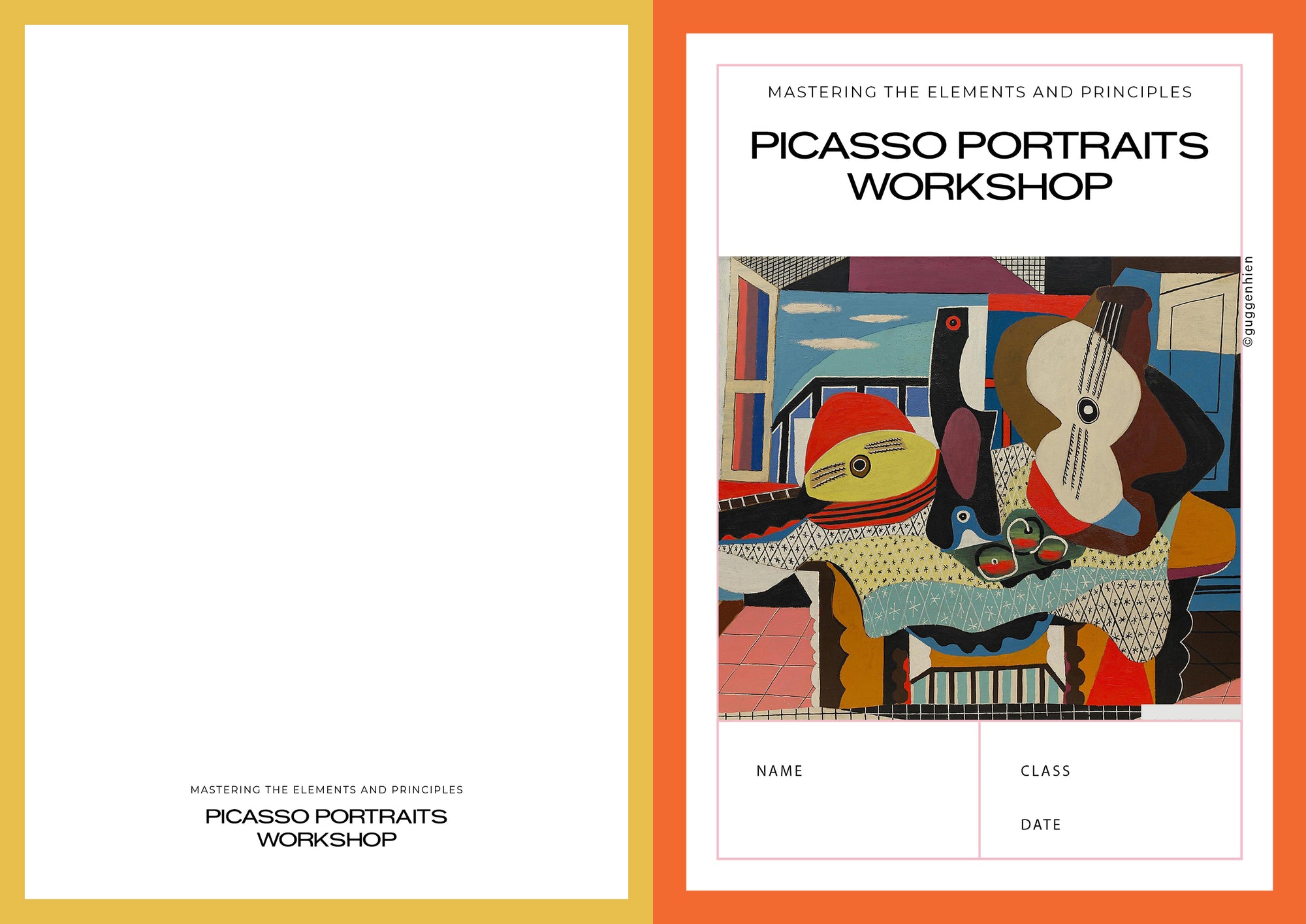
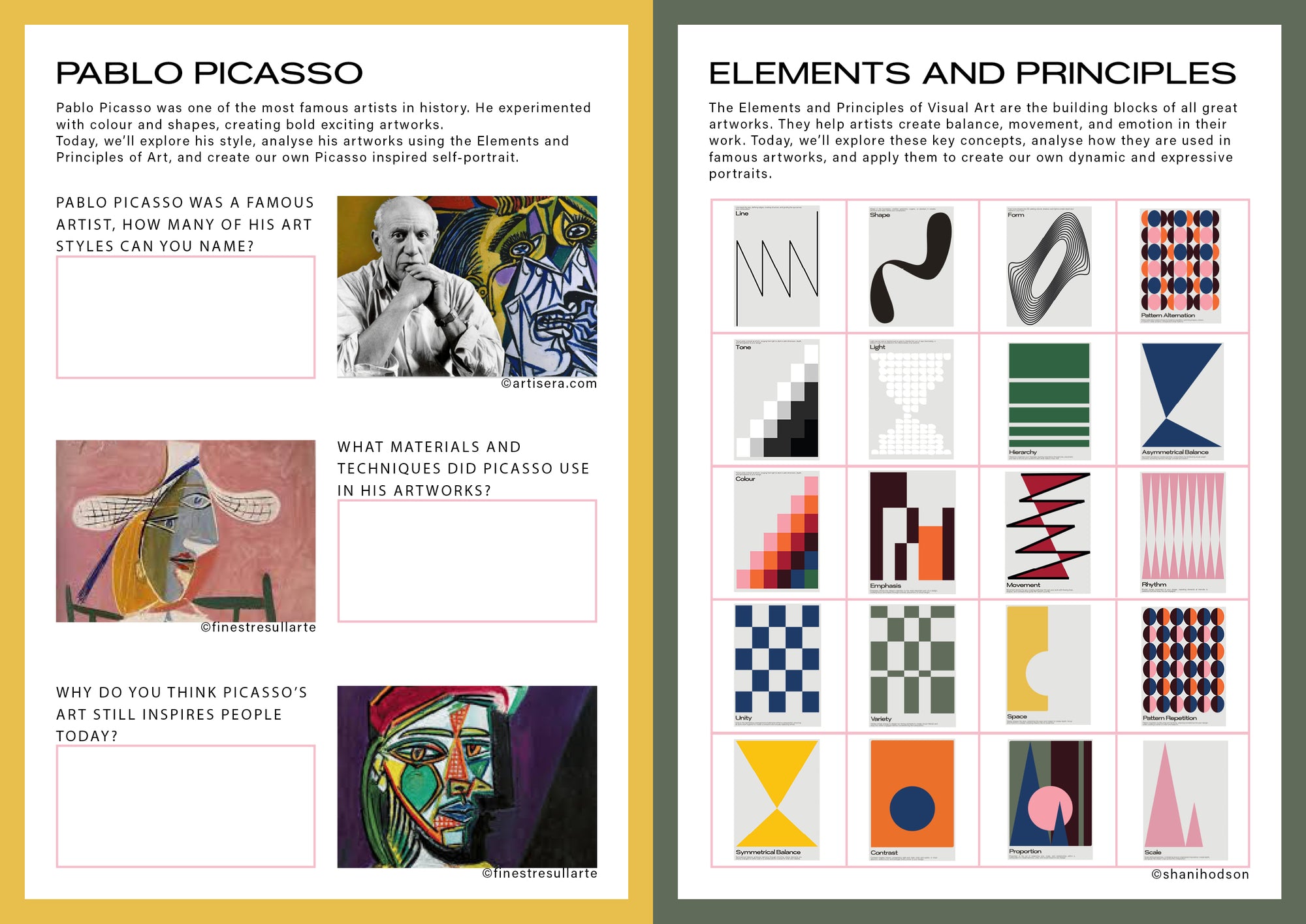
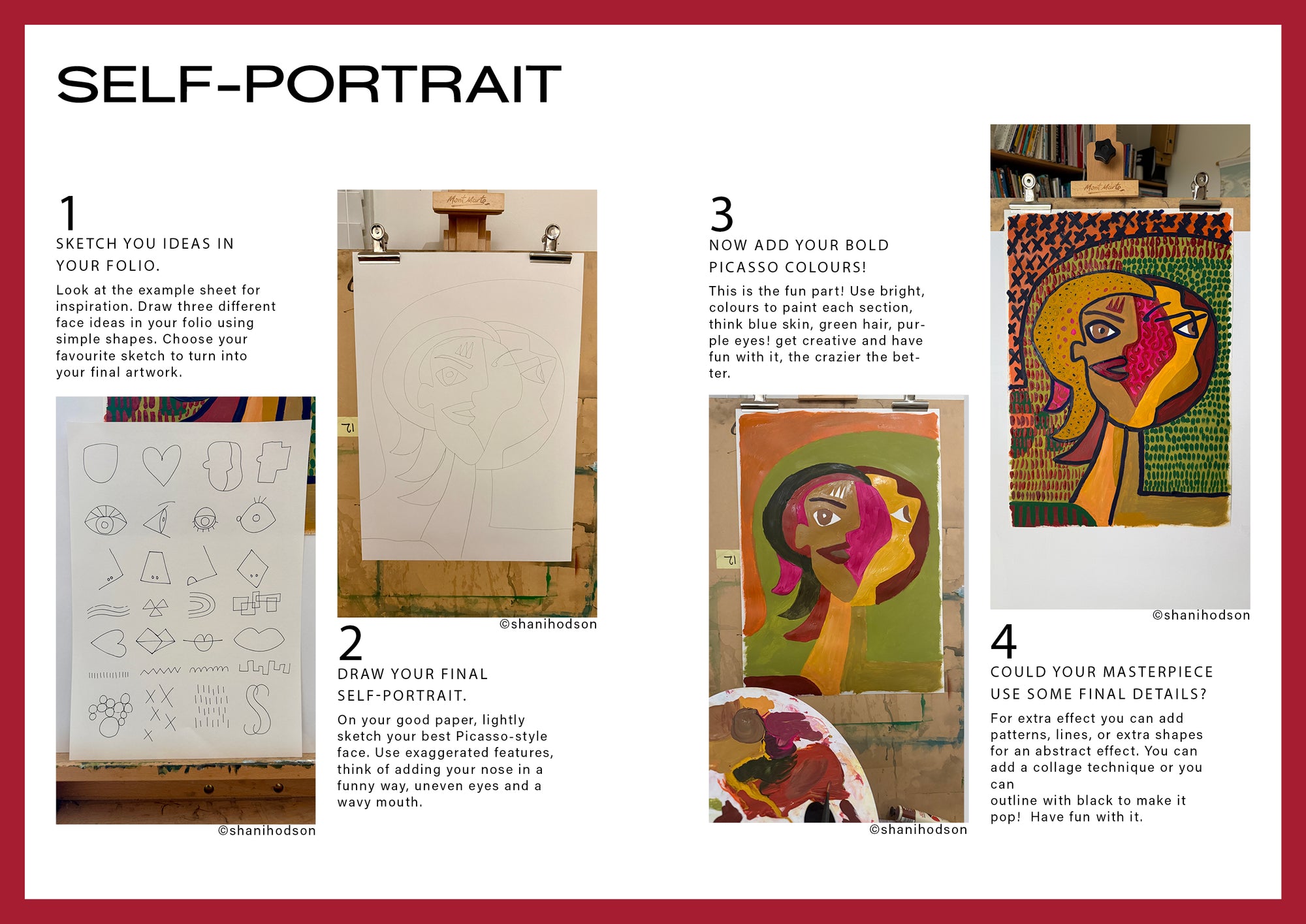

The Picasso Portrait Workshop has been specifically designed as an engaging and accessible introduction to the Elements and Principles of Art for Year 7 students, assuming they have little to no prior knowledge of these foundational concepts. Rather than presenting the elements and principles in an abstract or theoretical manner, the workshop immerses students in a hands-on, inquiry-based learning experience where they actively discover these concepts through observation, discussion, and art-making.

By embedding the Elements and Principles of Art into both analysis and creation, this workshop not only aligns with the Victorian curriculum but also ensures that students internalise these concepts organically, experiencing them in action rather than as rigid rules to memorise. This constructivist approach fosters creative confidence, critical thinking, and artistic exploration, setting a strong foundation for future art-making.

Building on this analysis, students then apply their learning by creating their own self-portrait, using Picasso’s abstract approach as inspiration. This practical task allows them to experiment with shape and form by fragmenting and reassembling their facial features in unexpected ways, reinforcing their understanding of abstraction and composition. The workbook serves as a scaffolded learning tool, guiding students through the creative process while prompting them to annotate and reflect on their work using the elements and principles.
To ensure inclusivity and differentiation, the workshop provides tiered entry points such as:
To offer structured guidance for students who may need additional support.
To allow students to construct their own portrait with guidance.
To challenge advanced students to experiment with distortion, colour theory, and expressive mark-making, deepening their engagement with the principles of movement, rhythm, and emphasis.
The Picasso Portrait Workshop is designed to immerse Year 7- 8 students in making and responding within the Visual Arts Curriculum 2.0 framework. This approach ensures that students not only develop their practical skills as artists but also engage critically with visual artworks as an audience, deepening their understanding of artistic techniques and visual communication (Victorian Curriculum and Assessment Authority, 2025).
As artists, students will explore Picasso’s techniques by creating self-portraits that emphasise abstraction, geometric form, and expressive colour. This aligns with the Exploring strand of the Victorian Curriculum and Assessment Authority (2025).
They will engage in a scaffolded creative process, with options ranging from pre-made templates for those requiring additional support to extension tasks for advanced learners, ensuring accessibility and challenge for all students. Through this, they will develop their technical and conceptual skills, applying various media and techniques to complete their final piece (Victorian Curriculum and Assessment Authority, 2025).
As the audience, students will critically analyse Picasso’s Mandolin and Guitar (1924) using an Elements and Principles of Art worksheet, identifying key artistic conventions and discussing their significance. This process aligns with the Developing Practises strand, as students engage in reflective discussions about Picasso’s influence and the impact of abstraction on modern art.
Finally, they will present and annotate their own work, considering how their artistic decisions align with the elements and principles. These reflective tasks encourage students to think deeply about their creative choices, fostering critical analysis skills that enhance both their artistic practice and their ability to interpret visual culture (Victorian Curriculum and Assessment Authority, 2025).
By integrating both making and responding, this workbook supports students in developing a dual perspective as both artist and audience, reinforcing their ability to communicate visually, think critically, and engage with art in a meaningful way (Victorian Curriculum and Assessment Authority, 2025).
The Picasso Portrait Workshop has been specifically designed as an engaging and accessible introduction to the Elements and Principles of Art for Year 7 students, assuming they have little to no prior knowledge of these foundational concepts. Rather than presenting the elements and principles in an abstract or theoretical manner, the workshop immerses students in a hands-on, inquiry-based learning experience where they actively discover these concepts through observation, discussion, and art-making.
The workshop begins with an interactive PowerPoint presentation on Picasso, where students are introduced to his life, artistic style, and the key concepts of his artistic style. This is followed by a group discussion on the Elements and Principles of Art, where students explore how these concepts are applied in Picasso’s works. The discussion encourages students to think critically about how artists use elements like line, shape, and colour to create meaning, while principles like balance, contrast, and rhythm contribute to the overall composition (Porzio & Valsecchi, 1974).

The workshop continues on from the powerpoint with a group analysis of Picasso’s Mandolin and Guitar (1924), guiding students to identify and describe the visual arts conventions used in the artwork. This discussion encourages them to notice key elements such as shape, colour, and line, and how Picasso manipulates these to create abstracted forms. Through facilitated questioning, students are introduced to principles like balance, contrast, and emphasis, developing an understanding of how these elements work together to communicate meaning. This approach aligns with the Victorian Curriculum 2.0, which encourages students to analyse how artists use visual conventions and techniques to convey ideas (Victorian Curriculum and Assessment Authority, 2025)..
By embedding the Elements and Principles of Art into both analysis and creation, this workshop not only aligns with the Victorian curriculum but also ensures that students internalise these concepts organically, experiencing them in action rather than as rigid rules to memorise. This constructivist approach fosters creative confidence, critical thinking, and artistic exploration, setting a strong foundation for future art-making.



Building on this analysis, students then apply their learning by creating their own self-portrait, using Picasso’s abstract approach as inspiration. This practical task allows them to experiment with shape and form by fragmenting and reassembling their facial features in unexpected ways, reinforcing their understanding of abstraction and composition. The workbook serves as a scaffolded learning tool, guiding students through the creative process while prompting them to annotate and reflect on their work using the elements and principles.
To ensure inclusivity and differentiation, the workshop provides tiered entry points such as:
To offer structured guidance for students who may need additional support.
To allow students to construct their own portrait with guidance.
To challenge advanced students to experiment with distortion, colour theory, and expressive mark-making, deepening their engagement with the principles of movement, rhythm, and emphasis.

The Picasso Portrait Workshop is designed to immerse Year 7- 8 students in making and responding within the Visual Arts Curriculum 2.0 framework. This approach ensures that students not only develop their practical skills as artists but also engage critically with visual artworks as an audience, deepening their understanding of artistic techniques and visual communication (Victorian Curriculum and Assessment Authority, 2025).
As artists, students will explore Picasso’s techniques by creating self-portraits that emphasise abstraction, geometric form, and expressive colour. This aligns with the Exploring strand of the Victorian Curriculum and Assessment Authority (2025).
They will engage in a scaffolded creative process, with options ranging from pre-made templates for those requiring additional support to extension tasks for advanced learners, ensuring accessibility and challenge for all students. Through this, they will develop their technical and conceptual skills, applying various media and techniques to complete their final piece (Victorian Curriculum and Assessment Authority, 2025).
As the audience, students will critically analyse Picasso’s Mandolin and Guitar (1924) using an Elements and Principles of Art worksheet, identifying key artistic conventions and discussing their significance. This process aligns with the Developing Practises strand, as students engage in reflective discussions about Picasso’s influence and the impact of abstraction on modern art.
Finally, they will present and annotate their own work, considering how their artistic decisions align with the elements and principles. These reflective tasks encourage students to think deeply about their creative choices, fostering critical analysis skills that enhance both their artistic practice and their ability to interpret visual culture (Victorian Curriculum and Assessment Authority, 2025).
By integrating both making and responding, this workbook supports students in developing a dual perspective as both artist and audience, reinforcing their ability to communicate visually, think critically, and engage with art in a meaningful way (Victorian Curriculum and Assessment Authority, 2025).

The Powerpoint
Picasso Portrait Workshop Curriculum Alignment 2.0
The Frameworks

HITS Alignment with the Picasso Portrait Workshop
Setting Goals (Standard 1)
The workshop includes clear learning intentions and success criteria, ensuring students understand what they will achieve by the end of the session.
Explicit Teaching (Standard 3)
The lesson begins with an interactive PowerPoint presentation on Picasso, introducing students to his artistic style and key influences.
Worked Example (Standard 4)
To scaffold student understanding, an example of a Picasso-inspired portrait is provided.
Collaborative Learning (Standard 5)
Students work together in a group annotation activity, analysing Picasso’s Mandolin and Guitar.
Questioning (Standard 7)
Throughout the session, targeted questioning is used to elicit student responses about Picasso’s artistic style and intentions.
Metacognitive Strategies – Self-Evaluation (Standard 8)
After completing their portraits, students engage in a self-evaluation task to reflect on their work.
Differentiated Teaching (Standard 10)
The workshop includes differentiated workbooks to cater to different learning needs.
(Department of Education and Training Victoria, 2020).
Image: ©shanihodson2025
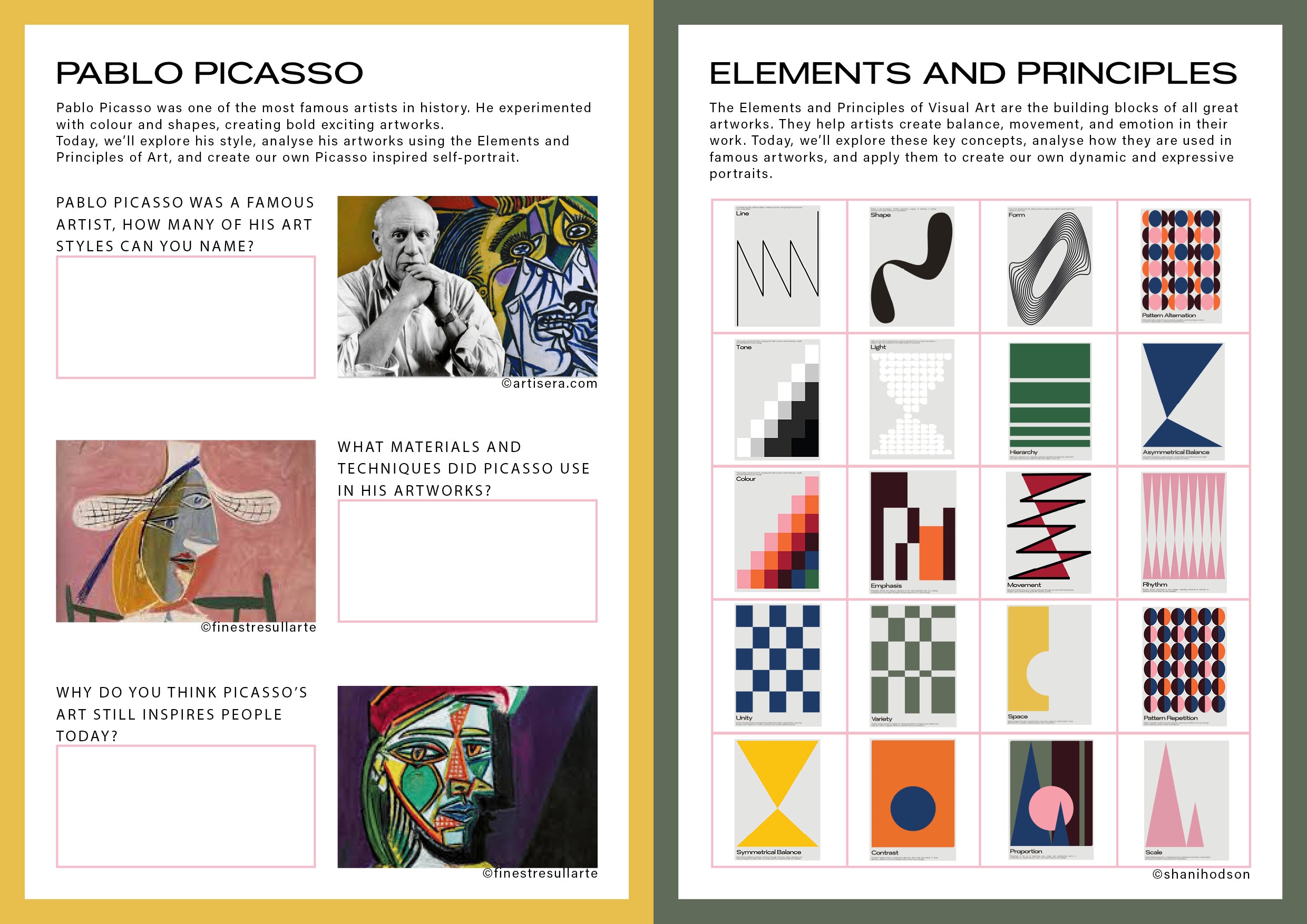
Remembering: Students recall prior knowledge of art elements and principles. They identify key facts about Picasso’s life and artistic
style from the PowerPoint presentation.
Understanding: Through group discussions, students interpret how Picasso
applied elements and principles in his work. They annotate Mandolin and Guitar, explaining artistic choices.
Applying: Students apply their knowledge by creating a Picasso-inspired portrait, integrating distorted features, bold colours, and abstract techniques.
Analysing: Students compare their own portrait with Picasso’s work. They analyse how different elements and principles (e.g., line, shape, colour) affect meaning in an artwork.
Evaluating: Through self-evaluation, students assess their artwork,
identifying strengths and areas for improvement.
Creating: Students generate an original Picasso-style portrait, making
independent design decisions.
(Anderson et al., 2001).
Image: ©shanihodson2025
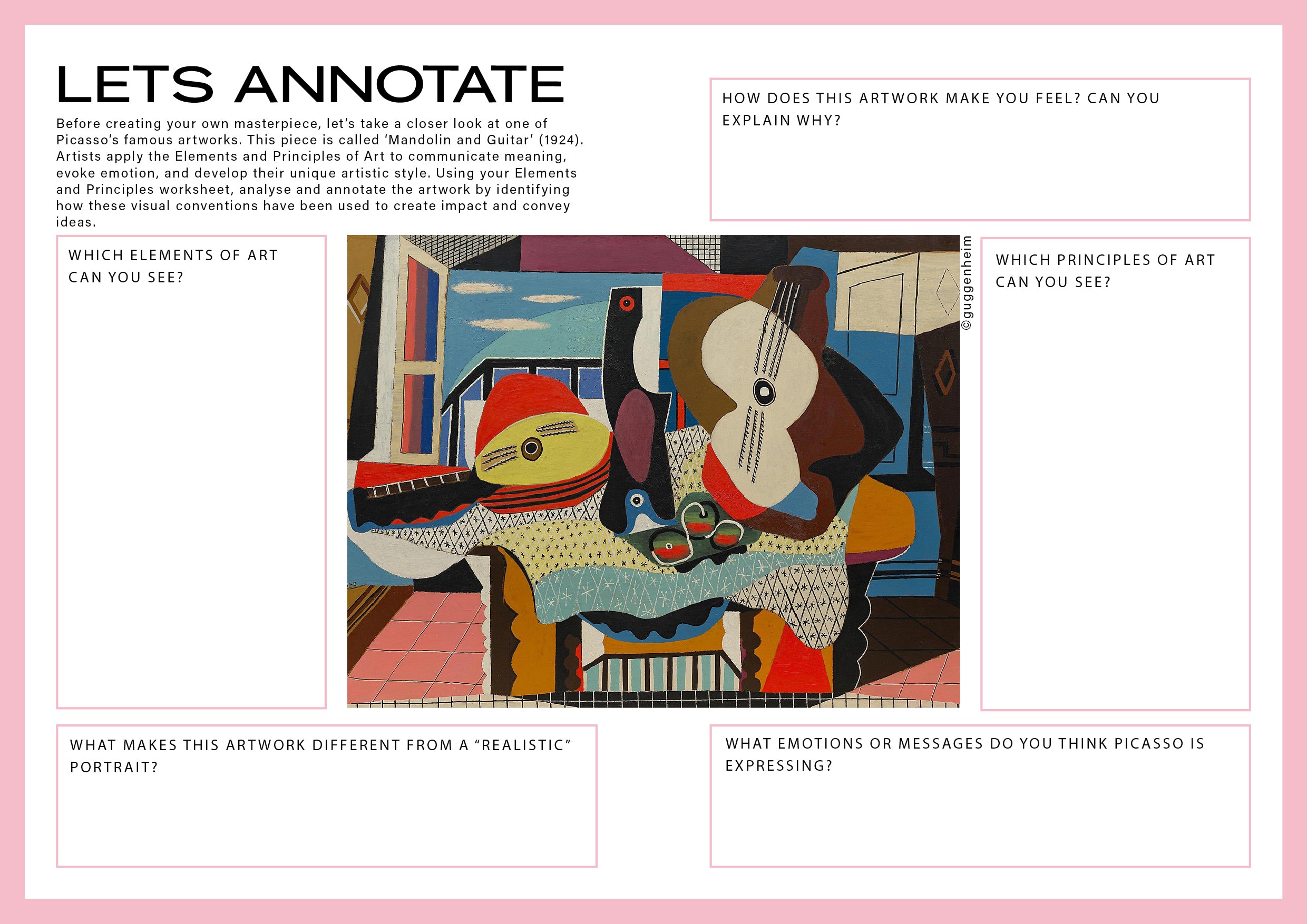
Standard 1: Know students and how they learn (1.2,1.5, 1.6) - The workshop is designed with the assumption that Year 7
students have limited prior knowledge of the Elements and Principles of Art,
ensuring that foundational concepts are explicitly introduced.
Standard 2: Know the content and how to teach it (2.1, 2.2, 2.5) - The workshop is aligned with the Victorian Curriculum 2.0,
addressing the four strands of Visual Arts: Exploring, Developing, Creating,
and Presenting.
Standard 3: Plan for and implement effective teaching and learning (3.1, 3.2, 3.4, 3.6) - The lesson includes clear learning intentions and success criteria (HITS Standard 1: Setting Goals). A worked example of a Picasso
portrait is provided (HITS Standard 4), giving students a visual and conceptual guide before they begin their own work.
Standard 5: Assess, provide feedback, and report on student learning (5.1, 5.2, 5.3) - Students engage in self-assessment and reflection, identifying what they would improve in their work. Teacher feedback is provided through formative assessment strategies, such as questioning, peer critique, and discussion.
Standard 6: Engage in professional learning (6.2,6.3) - The use of AITSL-aligned teaching strategies, HITS, and Blooms Taxonomy reflects a commitment to evidence-based teaching practices.
(AITSL, 2017).
Image: ©shanihodson2025
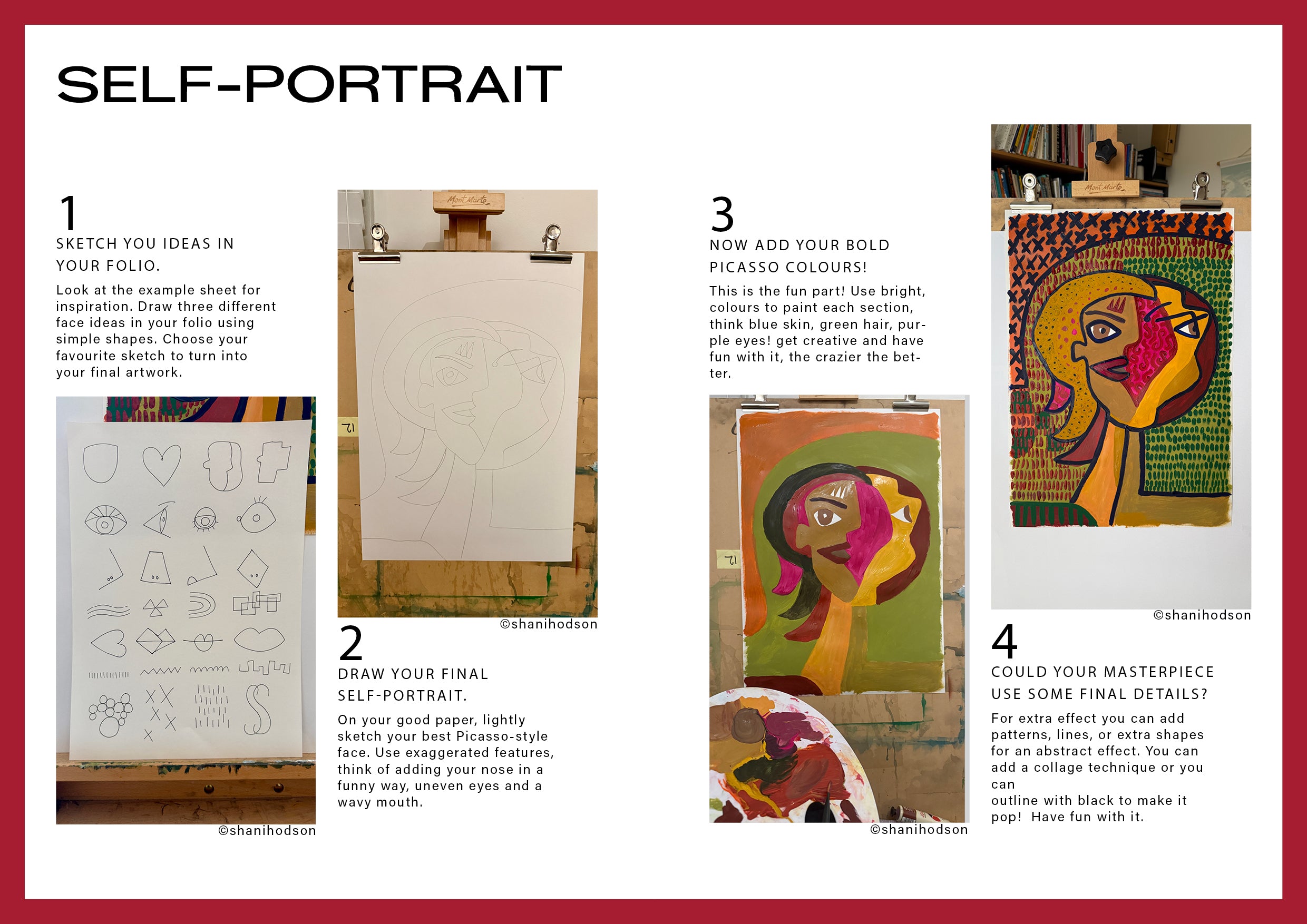
the foundational skills of Digital Literacy, Literacy, and Numeracy from the Victorian Curriculum F–10 Version 2.0 can be integrated to enhance student learning.
Literacy is embedded through the analysis and discussion of Picasso’s works, requiring students to articulate their observations using subject-specific vocabulary related to the Elements and Principles of Art. They will also engage in annotation and written reflection as part of their response to the artwork.
Digital Literacy may be incorporated through the interactive PowerPoint presentation, where students engage with digital media to explore Picasso’s techniques, as well as through digital extensions, such as creating Picasso-inspired portraits using design software.
Numeracy is relevant when discussing proportion, geometric forms, and spatial relationships within Picasso’s style, helping students understand how mathematical concepts inform artistic composition.
By incorporating these foundational skills, the workshop aligns with the Victorian Curriculum’s foundational skills approach, ensuring students develop competencies that support their broader learning across subjects.
(Department of Education and Training Victoria, 2020).
Image: ©shanihodson2025

Lev Vygotsky’s (1978) theory of scaffolding and the Zone of Proximal Development (ZPD) provides a strong foundation for structuring my workshop.
According to Vygotsky (1978), learning occurs most effectively when students are guided by a more knowledgeable other, gradually gaining independence in mastering new skills. Scaffolding instruction ensures that tasks are slightly beyond the learner’s current abilities but achievable with support. The workshop will apply scaffolding through structured guidance, modeling, and gradual release of responsibility to foster deeper learning (Vygotsky, 1978).
Image: ©shanihodson2025
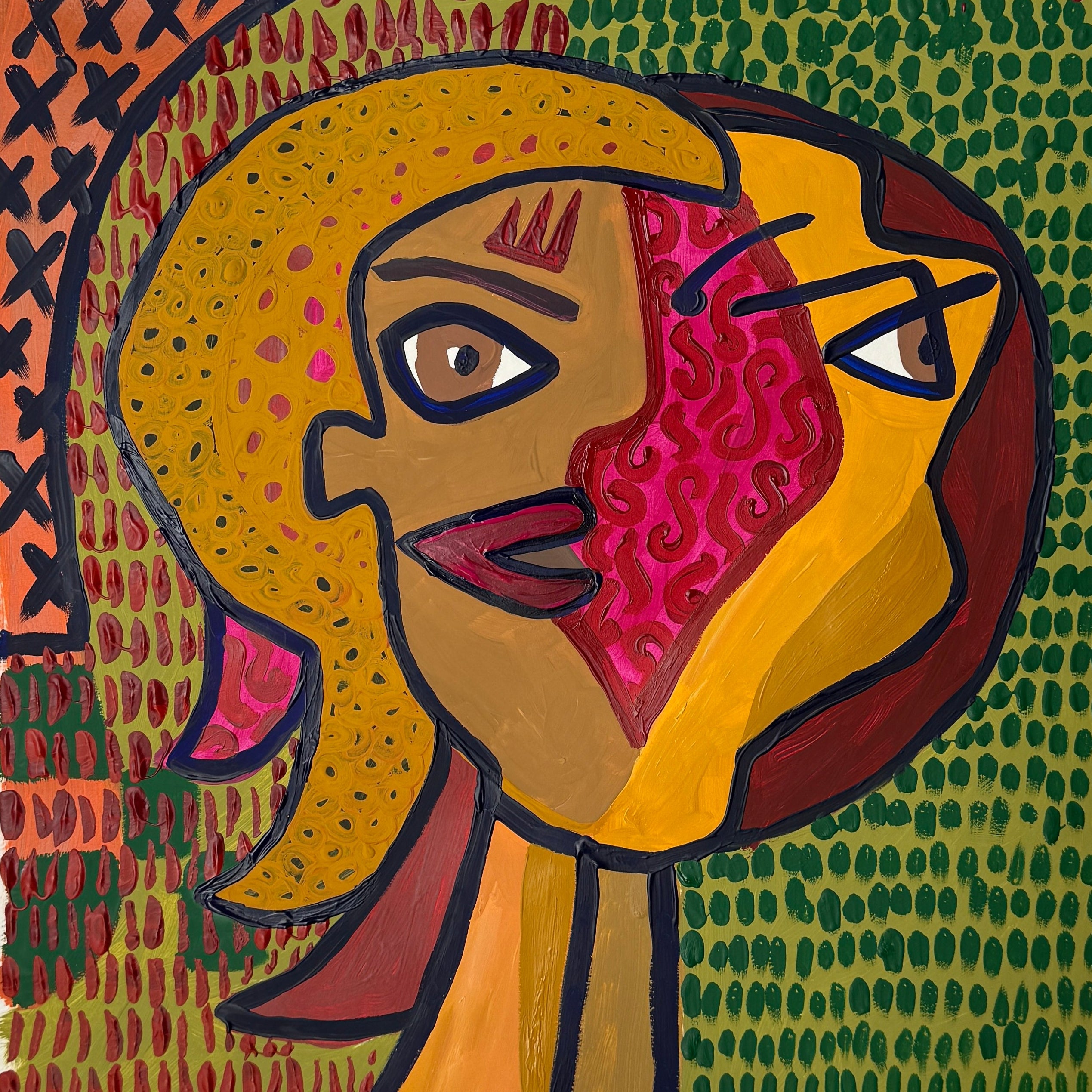
Cognitive Load Theory (Sweller, 1998).
Sweller’s (1998), Cognitive Load Theory (CLT) provides a strong theoretical foundation for using a full-colour brochure in the workshop. CLT explains that learning is most effective when instructional materials are designed to reduce extraneous cognitive load, allowing students to focus on essential content without becoming overwhelmed. The brochure serves as a structured, visually appealing support tool that aligns with Sweller’s (1998) principles, ensuring that learners can process and retain information more efficiently.
Addressing economic concerns:
A non-printable, slideshow-based version ensures that the workshop can still be delivered in schools where printing resources are limited.
The adaptability of the resource means that it remains accessible across various school settings.
Image: ©shanihodson2025
Your cart is currently empty.